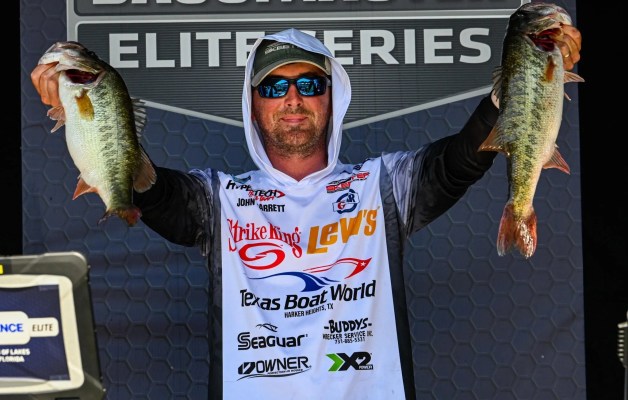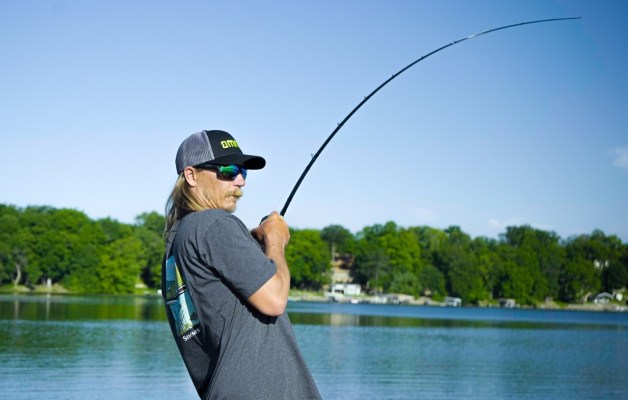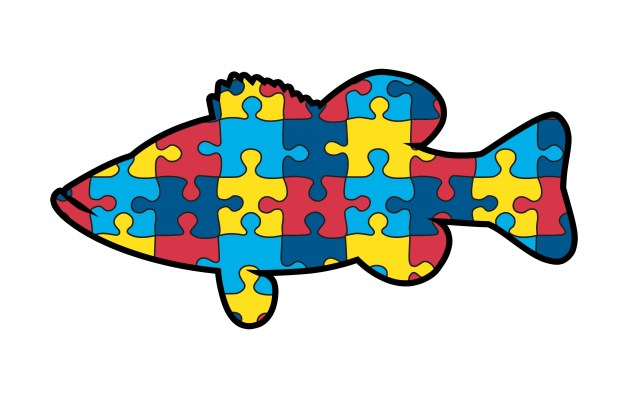We all know that if the water is dirty, the fish are going to be shallow, so flipping, cranking and spinnerbaits come into play.
But this is the time of year we start encountering clear water, and swimbaits work into my strategy.
They allow me to cover water but yet I can fish a little slower, keep the bait in the strike zone longer and make the fish react.
When you have post-frontal conditions and clear water, bass are less likely to bite the standard reaction baits, but they will eat a swimbait.
There are two types of swimbaits I use this time of year — the Strike King Swimming Caffeine Shad and the basic Caffeine Shad. The Swimming Caffeine Shad has a swimbait-style tail that kicks from side to side and looks like a baitfish swimming around. The Caffeine Shad is shaped like standard soft stickbaits with a tapering tail.
Both baits are very versatile. If I’m fishing a highland lake without much brush or vegetation, I rig the Swimming Shad on an open jighead and wind it through the water column.
If I’m fishing around grass or brush, I’ll fish both baits Texas style (hook point protected) on either a belly-weighted hook or an unweighted hook.
The soft stickbait version is more of a quiet killer. Most people think the Caffeine Shad is just another soft stickbait, but it’s a lot more versatile because it’s so soft and loaded with salt. Because of its attributes, I can fish it fast or slow. I’ll twitch it like I do other stickbaits, but I like to kill it and let it fall seductively.
I like to change speeds a lot with both of these baits. I’ll speed it up and slow it down until I figure out what makes the fish react best. When the water warms up, speed changes and erratic movements trigger more bites.
Water depth and clarity often determine whether I weight either bait. For example, if I’m fishing Table Rock in the spring and can see bottom in 15 feet of water I may use a 1/16-ounce belly-weighted hook to get a faster sink rate and work the bait deeper.
However, I’m not opposed to fishing the regular Caffeine Shad unweighted with a large offset hook and let it sink slowly, especially around boat docks and flooded bushes. It’s got a unique quiver.
When the water is warmer, I use a heavier weight and fish it faster and on a high speed reel, big rod and fluorocarbon line. If I’m fishing around thick vegetation or brush, I’ll fish it on braid.
Speed changes are especially important on bright sunny days when fishing clear water. Sometimes I’m just twitching it along a few times, then I spin the reel handle quickly for about 10 feet kill it.
The key is to pay attention to the lure. Watch for fish following it and see what makes them react best. Some days they want it fast; other days they want it twitched along. Keep experimenting until you see what they want. Whatever you do, change speeds!
I base my size selection upon the mood of the fish. I generally use the 5-inch, but on tougher lakes and ultra clear water, I like to fish the 4-inch model on spinning gear with braid and make extremely long casts. It’s a great choice for skipping along the bank under overhanging trees.
Natural watermelon colors are best for clear water, but my favorite is the KVD Magic that is a natural baitfish color. If the water is stained, I like brighter colors, like pearl and shad.
If bass are ignoring your standard lures, tie on a swimbait, cover water and vary the speed at which you fish it. The bass can’t stand that erratic action.





